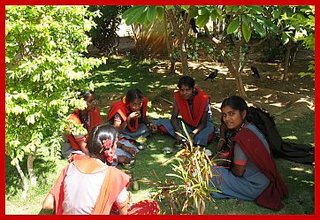BLESSINGS OF GANESHA FROM ARUNACHALA
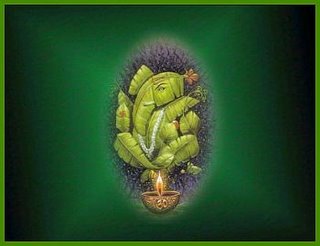
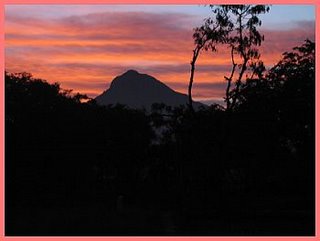
Hesitant light glows, shaded in hues of crimson
Purple strands wrap around rosy fabric
Shining whispers gaining strength with each passing moment
Growing courage and covering the haloed heavens
With a splendid legacy of auspicious hope
Billowed vapors coalesce, gathering to bloom
Fields of mystic blossoms bending low to breezes
Sensitive, each responsive flower turning its face
Into the brilliance of the morning sun
To float away and meet the distant horizon
Feathered friends of angels soar on cushioned air
Singing songs of glorious restoration
Hopeful joy lands delicate, tenderly embracing
Uniting memoirs of yesterday with the promise of today.
[unknown]


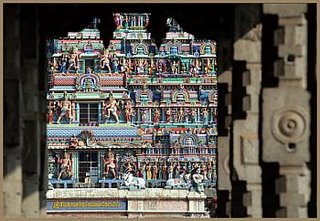


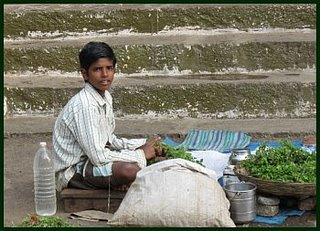
Below is one of the rest-a-while parks that are dotted around the fringe of the pradakshina pathway. Unfortunately the parks nearly always seem to be locked, maybe the park caretakers don't trust us enough to keep the park clean in their absence! A Bonnet Macaque monkey is hanging around in front of the park. At the beginning of my walk I bought a large bag of rusk bread for the monkeys and dogs but ran out of supplies quickly and had to purchase more on the way.
Please do remember if you feed the monkeys to throw the food off the road. Even though it is easier for them to pick up food from the tarred roads, doing so makes the monkeys lose their fear of the street and so leads to accidents. The monkeys are tame and generally very well mannered.

These two kids are visiting Tiruvannamalai for the first time with their Mother. They hail from Chennai and were particularly proud of their nice, new tonsures from the Arunachaleswarar Temple.
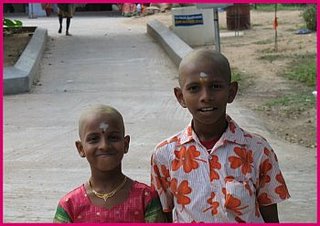
Unfortunately nobody keeps to the recommendations either regarding the use of the horn or speed restriction. Hopefully when the ring road finally gets built heavy traffic will no longer use the giripradakshina pathway.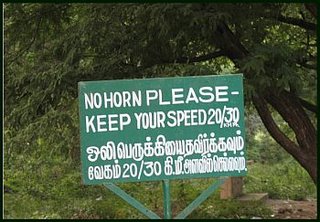
What you see below is becoming increasingly common on the giripradakshina road. About 10 years ago the pathway was unlighted and in a narrow and poor, rutted condition. Even though the intentions were kind hearted, the consequences of widening the road and providing bright lighting, has had unfortunate consequences. Because now pilgrims do not have right-of-way and are consistently pushed to the side of the road by speeding trucks and buses. This situation unfortunately doesn't improve during the evenings and nights because sadly, as the lighting is so excellent, heavy traffic constantly travels on the road.
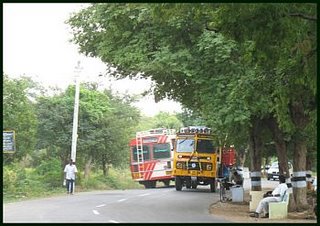
This decorated tree is a new item. In India ladies like to ornament special trees (specially located at shrines or holy spots) with personal items like bangles or auspicious threads in performance of a vow. I think this particular tree has been helped along by some enterprising folk who thereafter take up a nearby perch and sell items such as camphor and small clay plates, so that pilgrims can perform aarti (the waiving of light) to the tree.

Parents love to dress their children up like dollies. This little girl looks adorable with her bangles, flowers and necklace. The Mother, who was standing next to the child as I took the picture, was delighted that her beautiful angel was being admired and photographed.
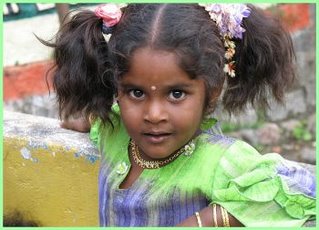
These gents are devotees of the God, Iyyapan. They are on their way to the famous Iyyapan Temple at Sabrimala. The journey to the Iyyapan Temple is almost as important as what happens once the pilgrim arrives. It is traditional that the journey itself is a pilgrimage, and devotees on their way to Sabrimala will stop off at designated shrines, holy places, saints or sadhus to perform different worships. A unique aspect of Sabrimala, is that there is a sex restriction. Gents are allowed, but as to ladies, only girls or older ladies are allowed to visit and ladies of childbearing age are not welcomed.



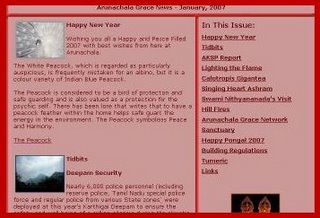
Arunachala Grace News, January 2007, is being sent out this week. The newsletter is completely free and is sent directly to your inbox. This month there is a report from Apeetha Arunagiri of the Arunachala Kattu Siva Plantation, a narrative from Govinda Bowley of the Mountain of Medicine about the Hill Fire on Arunachala during this year's Maha Deepam on December 3rd. We have news of the innovative work being done at the 'Singing Heart Ashram', a 'Tidbit Section' including a round-up of the latest news at Tiruvannamalai, information about the upcoming January visit of Swami Nithyanananda and also, reports on the herbs of Arunachala, poems and a wonderful satirical report on local 'building regulations'.
 [photograph of Sri Sadhu Om in front of Arunachala]
[photograph of Sri Sadhu Om in front of Arunachala]Soon after reading his book, I met Sri Sadhu Om, and I found that he was able to answer in an extremely clear, simple and convincing manner all the questions that I asked him about the philosophy and practice of the teachings of Sri Ramana. For the next eight-and-a-half years, until his passing away in March 1985, I was fortunate to be able to spend most of my waking life in the company of Sri Sadhu Om, and to imbibe from him a clear understanding of the philosophy, science and art of true self-knowledge as taught by Sri Ramana."
Michael James ended up living at Arunachala for the next twenty years. He has now launched a website and hopes to continue adding more content to his site in the form of e-books, articles, translations and explanations of all the original writings of Sri Bhagavan.
At present the main content of the site is a PDF version of his new book, 'Happiness and the Art of Being', which is intended to serve both as a layman's introduction to the philosophy and practice of Bhagavan's teachings and as a detailed and in-depth exploration of the core elements of those teachings. To find out more about the life of Michael James, his teacher Sadhu Om and the teachings of Self-Enquiry please visit: www.happinessofbeing.com

An NGO (Non Governmental Organisation) which has been working for the uplift of blind people, has come up with a scheme entitled 'Nethradhenu' that would lend a helping hand to the visually impaired. The project, introduced six months ago, has members from Tamil Nadu Districts including Tiruvannamalai and is based on a Government scheme created to help elderly people in villages. In the case of 'Nethradhenu', the beneficiaries are visually-impaired illiterates in their 40's who are dependent on others. Under the scheme a Jersey cow and calf is given free of cost to a visually impaired recipient. The cow will be insured and it's milk will be procured by a private milk company.
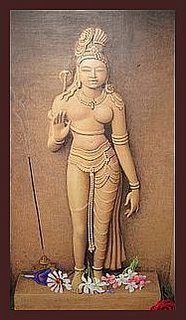
The effects of Arunachala can either begin while one is here or may manifest weeks after one has departed. It bodes very well as now a different type of energy is coming to town and people will be thereby influenced in many new extraordinary ways.
